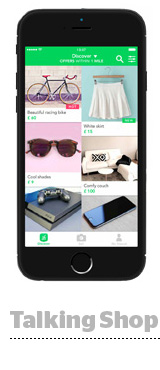
When Shpock, a European shopping app, started using search behavior to inform its ad targeting this year rather than just relying on demo data, it began to realize what its users were actually interested in.
“For many years, demographic targeting was one of the main options used by brands and agencies alike,” said Jon Hatfield, who joined Shpock as its head of advertising and technology a little under five months ago.
But the main attraction for advertisers is the “shopping mindset” of Shpock’s users, he said.
“People are on the platform to buy and sell,” Hatfield said. “For most advertisers this is the ideal time to engage with consumers, which is reflected in the performance we see from both direct and programmatic campaigns.”
Shpock – the name is a portmanteau of “shop” and “pocket,” as in “shop in your pocket” – was founded in Austria in 2012. The app, which also operates in Germany and the UK, was acquired by Norwegian publishing conglomerate Schibsted in 2015 and has more than 10 million active monthly users.
AdExchanger chatted with Hatfield.
 AdExchanger: How does Shpock monetize?
AdExchanger: How does Shpock monetize?
JONATHAN HATFIELD: Advertising is our biggest revenue stream by some margin. We also generate revenue through in-app purchases used to promote items higher up in the listings. In the past year we’ve had a big push on “pro-seller” accounts, especially in the automotive area.
Who’s your audience?
Before I joined, my perception, based on Shpock’s TV ads and branding, was that we were very focused on a younger audience. But once I started to work here and was able to look behind the scenes, it became clear that the audience is much more representative and spread across different ages.
When Shpock launched in 2012, it was one of the first mobile apps for shopping, and the majority of its users were younger. But as time went on, mobile increasingly became the way people of all ages interact with the digital world and the Shpock community became broader.
Which is partly why it makes sense not to get too hung up on demographic data.
Demographics are not secondary to data based on actual behavior. The two can coexist. Using our search data to target a campaign and then examining the demographic traits of the users we targeted is a real step forward, because it shows us a truer reflection of who is interested in that product. These insights can then be fed back to the brand or agency to help inform future online activity or be taken offline and used in other parts of the product life cycle.
Do you sell programmatically?
Almost all of our inventory is available to buy programmatically. Advertisers can transact through the open market, PMPs, programmatic guaranteed or direct, whatever works best for the given activity. If a buyer is super focused on driving the absolute lowest cost per lead, programmatic is likely the best option, but running direct can offer some exclusive benefits, such as extra layers of data, analysis or insights.
What’s in your tech stack?
For the most part, our tech stack resembles many others: We have an ad server, a handful of different SSPs and a variety of first- and third-party analytics tools. Where it gets more interesting is with our data management and event tracing platform, CRM system and push notification delivery service, all of which were developed in-house. The way we integrate these into our advertising business is where we can gain a competitive edge.
As an app publisher, what do you need from your tech vendors?
We work with a number of the big tech partners, including Google, Facebook, OpenX and Rubicon. One of the main challenge is finding the best way to integrate all of our partners into a unified auction. In web environments, this is a much easier task with the proliferation of header bidding and Google’s Exchange Bidding, but apps are still a bit trickier. Development in the wider industry has lagged.
There’s good reason for this. Most of the traditional large media owners still have a heavy reliance on web platforms, and while there are a lot of apps that rely on app revenue, most have relatively small teams, and their focus is on product development. A unified auction isn’t high up on the priority list, but it’s only a matter of time. In the past year we’ve seen more interest. Given our user base, it’s a big focus for us, and we have a number of projects in the coming months, including an RTB server implementation for mobile app.
This post was syndicated from Ad Exchanger.


More Stories
Warner Bros. Discovery CEO David Zaslav Receives $51.9 Million Pay Package for 2024
TikTok Fave Duolingo Boosts YouTube Shorts Viewership 430% in One Year
Streaming Ratings, Week of March 10: Disney+ Sails to the Top Courtesy of Moana 2